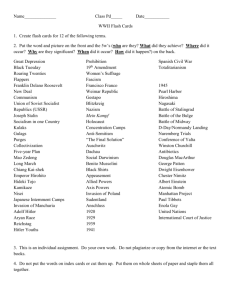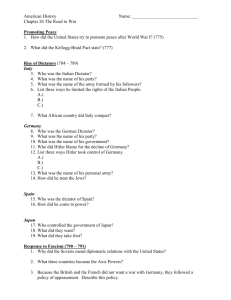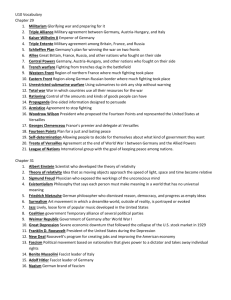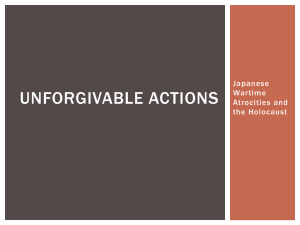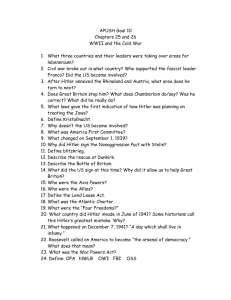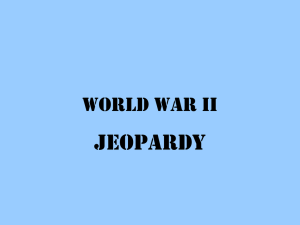WORLD WAR ii
advertisement
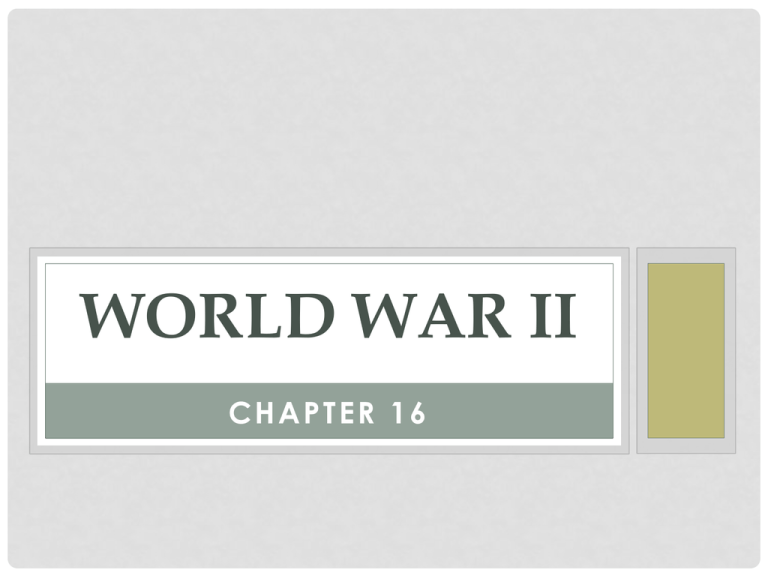
WORLD WAR II CHAPTER 16 HITLER’S LIGHTNING WAR – SECTION 1 1. What did each leader gain from the secret agreement (the non-aggression pact)? • Hitler – removal of threat of attack from the east, division of Poland • Stalin – division of Poland, takeover of Finland and Baltic countries, safety from German attack 2. What strategy did Hitler use to conquer Poland? • “Blitzkrieg” or “lightning war” – using fast moving mechanized weapons and overwhelming force. 3. What was Hitler’s plan for conquering France? • Pave a way to France and distract Allies by invading Holland, Belgium, and Luxembourg • Then send massive force through the Ardennes 4. What happened at Dunkirk? • Britain rescued Allied soldiers stranded at Dunkirk and ferried them to safety across the English channel 5. What was the outcome of the Battle of Britain? • RAF fighters and British resistance forced Germany to call off the attack 6. What was the outcome of the fighting at Tobruk? • By the beginning of 1942, the British had forced Rommel to retreat. By the middle of the year, Rommel pushed the British back and seized Tobruk 7. How did Hitler’s invasion compare with Napoleon’s invasion of Russia? • In both invasions, Russia’s terrible winter and its strategy of destroying everything in the enemy’s path created severe hardships for the invaders. JAPAN’S PACIFIC CAMPAIGN – SECTION 2 1. Bombing of Pearl Harbor – a. Japanese launched surprise attack, striking or damaging almost the entire U.S. Pacific Fleet b. U.S. declared war on Japan 2. Fall of Southeast Asian colonies – a. Through a planned series of attacks in the Pacific, Japan seized control of rich European colonies b. Helped Japan replenish depleted resources 3. Doolittle’s raid on Japan – a. As a revenge for Pear Harbor, U.S. sent 16 B-25 bombers to bomb Japanese cities b. Showed that Japan could be attacked and raised American morale 4. Battle of the Coral Sea – a. Following interception of Japanese attack on Port Moresby, Japanese and American naval fleets fought to a draw b. Introduced a new kind of naval warfare using only airplanes; stopped Japan’s expansion southward 5. Battle of Midway – a. American carrier planes defeated Japanese fleet poised to attack Midway Island, a key American airfield b. Reversed the tide of war in the Pacific 6. Battle of Guadalcanal – a. U.S. Marines with Australian support, seized Japanese airfield and fought on land and sea for control of island of Guadalcanal b. Forced Japan to abandon island of Guadalcanal; began MacArthur’s island-hopping counterattack THE HOLOCAUST – SECTION 3 1. WHO? 1. Who were victims? • non-Aryan peoples – primarily Jews 2. Who were the “master race”? • Aryans – Hitler favored blonde hair & blue eyes 2. WHAT? 1. What were Nuremberg laws? • German laws depriving Jews of rights to citizenship & jobs 2. What happened on night of Nov. 9, 1938? • Kristallnacht, the Nazis launched a violent attack on Jewish communities all over Germany 3. What was the “final solution”? • Systematic killing of entire groups of people, particularly Jews whom the Nazis saw as inferior 3. WHERE? 3. Where did German Jews try to migrate to find safety from Nazi terror? * France, Britain, the United States, & other allied nations 3. Where were Jews forced to live in German-controlled cities? * In Ghettos – segregated Jewish areas 3. Where were the concentration camps? * Mainly in Germany and Poland 4. WHY? 4. Why did Hitler believe that Jews and other “sub-humans” had to be exterminated? * To protect the purity of the Aryan race 4. Why did Germans build extermination camps? * To carry our mass murders in huge gas chambers 5. WHEN? 5. When did the final stage of the Final solution begin? * Early 1942 6. HOW? 6. How did non-Jewish people try to save Jews from the horrors of Nazism? * By hiding Jews in their homes or helping them escape to neutral countries 6. How many Jews died in the Holocaust? * Approximately 6 million THE ALLIED VICTORY – SECTION 4 1. Battle of El Alamein – • Forced Rommel & his troops to retreat westward from Egypt 2. Operation Torch – • Landed American troops in North Africa; finally crushed Rommel’s Afrika Korps 3. Battle of Stalingrad – • Put German forces on the defensive with the Soviets, pushing them westward 4. Invasion of Italy – • Resulted in Allied conquest of Sicily and forced eventual surrender of Italy 5. Propaganda campaigns on home front – • Rallied people on the home front to do their part to support the war effort 6. D-Day Invasion – • Opened a second front in Europe • Led to the liberation of France, Belgium, Luxembourg, and much of the Netherlands from Nazi occupation 7. Battle of the Bulge – • German offensive forced Allies to retreat • Allied resistance stopped Germans & resulted in heavy losses for Hitler 8. Battle of Leyte Gulf – • Wiped out the Japanese navy 9. Battle of Okinawa – • Resulted in heavy losses for Japanese & moved Allies closer to an invasion of Japanese homeland 10. Bombing of Hiroshima & Nagasaki – • Forced surrender of Japan & the end of war EUROPE AND JAPAN IN RUINS – SECTION 5 1. 3 ways war affected land & people in Europe – • Destroyed cities, factories, farmland, & utilities • Resulting in a ruined economy, shortages, famine, disease, unemployment • Destroyed lives 2. 3 political problems postwar governments faced – • Displaced persons • Discredited governments with lack of political leadership • Threat of communist takeovers 3. 1 way the allies dealt with the Holocaust – • Put Nazis on trial for “crimes against humanity” 4. 2 effects of Allied bombing raids on Japan – • Destroyed cities • Shattered economy • Caused deaths of 2 million people 5. 3 ways U.S. occupation changed Japan – • Government was democratized • Land ownership was expanded • Standing army was disbanded • Independent labor unions were formed 6. 3 provisions in Japan’s new constitution - • Two-house parliament (Diet) elected by the people • Prime Minister chosen by majority of diet as head of government • Voting rights for everyone over the age of 20 • Japan forbidden to start an offensive war

